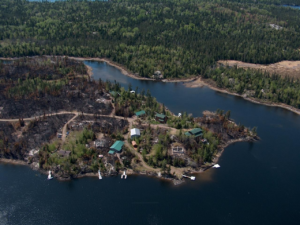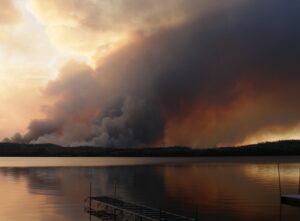Fire is a fundamental and natural factor in the boreal forests of northern Minnesota. It shapes the landscape and plays an essential role in the ecosystem.
The dense and primarily coniferous boreal forests of northeastern Minnesota and Canada experience frequent forest fires, whether caused by lightning or human activity.
With giant plumes of smoke and bright orange flames, forest fires may be viewed by the public as a destructive force that negatively impacts the landscape. While that is undoubtedly the case in some instances surrounding densely populated areas, fire can also provide significant ecological benefits.
When introduced to the boreal landscape in small and frequent amounts, forest fires support nutrient cycling, forest regeneration, habitat improvement, and pest control, creating a healthy and thriving forest overall. Forest fires, in essence, push the manual reset button on the landscape, leading to a recycling of the environment.

Nutrient Cycling & Forest Regeneration
Forest fires play a significant function in forest regeneration by clearing out dead and decaying vegetation on the boreal forest floor. The breakdown of dead trees and vegetation returns nutrients to the soil, further strengthening the surrounding trees. Furthermore, removing the thick understory allows sunlight to reach the forest floor, fostering the growth and development of a diverse range of plants and flora.
This natural process of forest regeneration provides ideal circumstances for one particular tree species in Minnesota: the jack pine. Jack pine cones are serotinous, meaning they depend on fire or high heat to open and release seeds. Without fire, the cones remain sealed with an impenetrable coat of resin. Fire is paramount for jack pine’s longevity and survivability in Minnesota and Canada’s boreal forests.
Resource Management & Habitat Improvement
Another beneficial facet of fire and forest regeneration relates to berries.
For decades, the U.S. Forest Service has used prescribed fire in targeted areas across the Superior National Forest for resource management. From timber to minerals, recreation, and berries, prescribed fire is used as a management tool that offers various benefits to wildlife and humans.
Blueberry picking season is a welcomed tradition to many Minnesotans each late summer and fall. Many grab an empty ice cream pail or bucket and venture into the woods to their secret blueberry-picking location. Like the jack pine, blueberry plants are fire-dependent and thrive on frequent cycles of forest fires. While humans benefit from the recreational and delicious joys of the Forest Service’s prescribed burn efforts, various wildlife, such as black bears, also reap the blueberry rewards.

The moose is another iconic species of the northern Minnesota landscape that benefits from the aftermath of a forest fire. Removing dense underbrush promotes the growth of shrubs, young saplings, and vegetation, an important and nutritious food source for the large Northwoods species.
In recent years, the U.S. Forest Service, Minnesota Department of Natural Resources, and Tribal Nations have focused their management efforts on providing and fostering high-quality habitat for moose as the overall population has declined. The 2024 moose population survey showed an estimate of 3,470 moose, down from an estimated 8,000 in 2005-2006. As part of the management strategy, targeted areas up the Gunflint Trail and Sawbill Trail have been selected for prescribed burns, specifically for moose habitat improvement. Additionally, the open areas created by fires offer ideal conditions for a broader range of species by providing a mosaic of varied habitats and resources.
Pest Control
Native species, such as the spruce budworm, and invasive species, like the spongy moth, are common in the northern Minnesota boreal forest. Each species rotates regularly and can cause severe defoliation and long-term impacts on the forest once an outbreak has occurred.
Forest fires and prescribed burns can play a crucial role in maintaining the health of boreal forests in northeastern Minnesota by reducing or eliminating populations of native and invasive pests. Fire helps to control pest populations by destroying their larvae and eggs, which are present in the foliage and bark of infested trees. Moreover, removing heavily infested and weakened trees through fire prevents the spread of pests to healthier forest areas.
In 2024, the U.S. Forest Service began the Blue Cascade Spruce Budworm project, a preventative mitigation effort in Cook County that aims to reduce heavily infested trees and hazardous fuels and minimize the density of spruce plantations to allow for more ecologically appropriate mixed forests. In total, the project encompasses over 2,000 acres.
The Downside: Wildland-Urban Interface
While there are numerous benefits of forest fires, whether introduced naturally by lightning or by human activity, they can have significant downsides in the area surrounding populated areas, such as the Gunflint Trail.
In years past, numerous large fires, such as the 2007 Ham Lake fire, the 2011 Pagami Creek fire, and the 2021 Greenwood fire, have wreaked havoc on the businesses and property owners surrounding the Gunflint Trail and the Boundary Waters Canoe Area Wilderness (BWCAW).

Driven by wind, dry conditions, and ample defoliated and dead trees on the landscape, forest fires can spread quickly, destroying property and causing the loss of livelihoods.
Additionally, the smoke from wildfires can severely degrade air quality, posing health risks to those with respiratory conditions and reducing the overall quality of life. Wildfires also put a strain on resources for emergency responders, wildland firefighters, and governmental agencies. The financial aspect of wildfires is worth noting. The 92,000-acre Pagami Creek fire in the Superior National Forest began with a lightning strike and eventually cost over $21.6 million to fight. In comparison, the 75,000-acre Ham Lake fire of 2007, ignited by an unattended campfire, cost $11 million.
In the immediate aftermath of a wildfire, the dynamic landscape is left scarred and prone to erosion, with charred trees and barren soil marking the devastation. However, over time—sometimes spanning decades—the forest undergoes a remarkable regeneration and vegetative recycling process.
As conditions improve, young jack pine and black spruce begin to take root, eventually growing into dense stands supporting diverse wildlife. Blueberry patches return to the nutrient-rich, post-fire soil, providing food for animals and humans. This natural succession restores the forest, contributing to its long-term health and resilience. Moving forward, the U.S. Forest Service aims to strike a delicate balance between mitigating fire risks near populated areas while maintaining the ecological benefits that fires bring to the boreal forest ecosystem.
Effective management strategies include continuing prescribed burns and forest thinning to reduce fuel loads and minimize the likelihood of catastrophic wildfires like the Pagami Creek fire. At the same time, these strategies promote biodiversity and forest health by mimicking natural fire cycles. This balanced approach seeks to protect the properties and livelihoods of the surrounding communities, while ensuring that the northern Minnesota boreal forest remains a vibrant and thriving ecosystem capable of sustaining its complex web of life.




